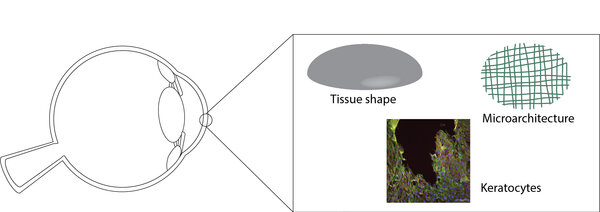
Description
Vision is one of the five senses human beings use every day in a wide range of tasks, however functional eyes are not self-evident for everyone. It is estimated that around 285 million people worldwide are visually impaired [1]. A considerate part of patients suffering from eye disease have a condition affecting the cornea. The most successful way of helping those patients is by means of keratoplasty, or corneal transplantation. This surgical procedure is the most commonly performed transplantation worldwide with 65.000 operations per year, however the demand for suitable donor tissue is still higher than the availability [2]. Hence, alternatives for allogenic transplants need to be developed, possibly by a tissue engineering approach.
Before a tissue engineered cornea becomes reality, we first have to understand the process of tissue formation and organization present in the stromal layer of the cornea. In this specific environment collagen lamellae are organized in an orthogonal lattice, but the underlying mechanism responsible for this organization is not yet understood. In this project we aim to find out what drives keratocytes to form orthogonally aligned collagen and thus what is necessary to build corneal tissue in vitro. Initially photo-patterning will be used to guide cell alignment and matrix deposition by means of contact guidance, after which this can be combined with additional environmental cues such as curvature.
References
[1] D. Pascolini and S.P. Mariotti, “Global estimates of visual impairment: 2010”, The British Journal of Opthalmology, Vol. 96, No. 5, pp. 614-618, 2012
[2] D.T.H. Tan, J.K.G. Dart, E.J. Holland and S. Kinoshita, “Corneal Transplantation”, The Lancet, vol. 379, no. 9827, pp. 1749-1761, 2012
Researchers
Researcher: C. (Cas) van der Putten.
Supervisors: N.A. (Nicholas) Kurniawan, S. (Sandra) Loerakker, C.V.C. (Carlijn) Bouten.
Funding by Chemelot InSciTe.
Contact
-
C. (Cas) van der Putten
-
N.A. (Nicholas) Kurniawan
-
S. (Sandra) Loerakker
-
C.V.C. (Carlijn) Bouten